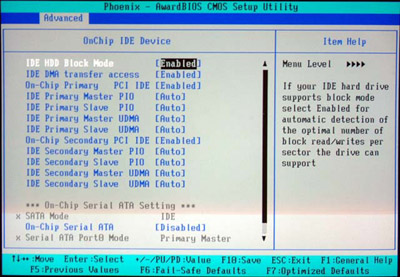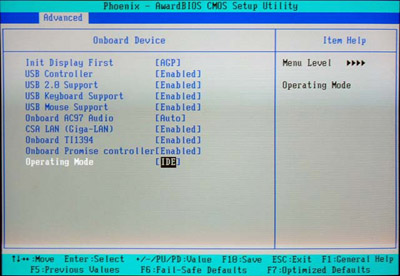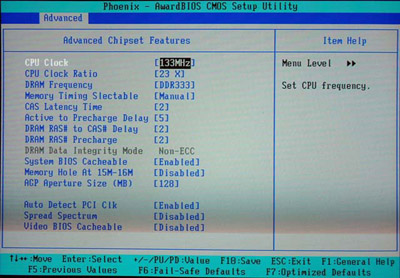Asus PC-DL Deluxe: 875 with Dual Xeons
by Wesley Fink on September 6, 2003 12:06 AM EST- Posted in
- Motherboards
Asus PC-DL: BIOS and Overclocking
Asus uses Award BIOS in the “drop-down menu” arrangement found on many Asus boards. If you’re familiar with the Asus implementation of Award and AMI BIOS on their other motherboards, then you will be very comfortable with the BIOS arrangement. It’s a little different than the more common Award arrangement, but all the information and choices are there — they’re just arranged a little differently.
Menu choices are across the top and as you navigate across, the dropdown menu’s change. Many of the menus that are standalone in traditional Award BIOS are nested under other headings here.

The Advanced menu provides access to 3 sub-menus for adjusting IDE-SATA and other on-Chip devices and ports.

The On-Chip IDE device section is where adjustments are made to IDE, and where Serial ATA and SATA RAID are setup.

Onboard Device provides control options for USB, audio, CSA LAN, firewire, and the Promise controller.

Memory timings, FSB, and Multiplier Ratios are adjusted in the Advanced Chipset Menu. Our Xeons allowed multiplier adjustment down, but we did not have options to set values higher than the stock 23X.

CPU FSB can be adjusted from stock 133 to 165, but there are no adjustments for Voltage or a “Fixed PCI/AGP” setting. This severely limits overclocking of the Dual-Xeon board.

Asus is well-known for their power control and adjustment options, and the PC-DL also has a complete selection of power on/off/save options. This is also the menu section with a submenu for Hardware Monitoring or PC Health.

The boot menu becomes very important if you have many drives or arrays connected to the PC-DL. You can manually select your preferred boot devices in this menu.
BIOS adjustments are complete as far as they go, but with Asus targeting the PC-DL to the Gamer and Enthusiast market, we really expected more options for overclocking the board. Right now, an option to lock the PCI/AGP bus would allow the current FSB range to be fully used. With the ability to use the same memory as the fastest Pentium 4 boards on the market, we certainly would appreciate voltage options for RAM and memory ratios to allow a wider range of memory speeds.
FSB Overclocking Results
Asus suggests this board is a great match to the 10,000 RPM Western Digital Raptor SATA drives in a SATA RAID 0 array. This would allow a cost-effective, but high-speed, workstation or small-server configuration. That sounded like a good idea, so the plan was to test the Asus PC-DL with dual Raptors in a SATA Raid 0. We know the SATA drives will not operate at any PCI setting other that 33, so we assumed Asus must have set up the board with an “always-on” PCI/AGP lock.It turned out we were wrong in our assumption. When you install a SATA Raid on the Asus PC-DL, all overclocking options are automatically turned off. We have contacted Asus for more information on whether this will be fixed in a future BIOS upgrade. When we have more information on this, we will post it here. Just be aware that at least for now, there will be no overclocking options at all if you use SATA drives on the Asus PC-DL.
Since we really wanted to see what the PC-DL could do with overclocking, we abandoned the plan to test with a fast SATA RAID array, and settled for benchmarking with an IDE drive. As soon as SATA is disabled in BIOS, the missing overclocking options, as limited as they are, magically reappear.
The following setup was used on the Asus PC-DL for FSB overclocking:
| Front Side Bus Overclocking Testbed | ||
| Processor: | Two Intel Xeon 3.06GHz (533FSB) with 1MB Cache |
|
| CPU Voltage: | Default | |
| Cooling: | Two Swiftech MCX603 with Two Panaflo high-output 80mm fans | |
| Memory: | 2x512MB Mushkin 3500 Level II | |
| Hard Drive: | Maxtor 120GB 7200 RPM (8MB Buffer) | |
| Power Supply: | Vantec Stealth 470W 24-pin ATX and 8-pin 12V |
|
While we could boot at overclocked speeds as high as the 160 (640FSB), the highest stable overclock we could achieve was 144 (576FSB or 3.3GHz). After having equipped the Dual Xeons with the great cooling capabilities of Dual Swiftech MCX603 heatsinks, we were very disappointed in this overclock. We are convinced this limitation is because of the lack of a PCI/AGP lock option in the BIOS, and it is probably a bus-speed limitation of our ATI Radeon 9800 PRO.
IT Professionals will probably find the very idea of overclocking a dual-Xeon board unthinkable, but please keep in mind that Asus told us they are targeting this board to gamers and computer enthusiasts. These 2 groups want to squeeze the absolute best performance out of their hardware. They will be very disappointed in current options for tweaking this board, and the limited overclocking that is possible compared to Pentium 4 875 boards.
Looking at the clock generators and voltage regulators on board, it certainly appears Asus can provide much wider tweaking and overclocking options in future BIOS upgrades. As it now is shipping, however, overclocking options are severely limited.










29 Comments
View All Comments
Kiwi42084 - Tuesday, March 2, 2004 - link
This Benchmark is totally unfair!!!!!The PC-DL has the avalibility to produce 4 usable CPUs...2 Physical and 2 Logical....
Windows XP will only see 2 of these. The benchmarks are being done with Half of the POWER POTENTIAL.
vppaul - Wednesday, February 25, 2004 - link
I am having a problem with my PC-DL board. The System Management BIOS is reporting that there is 4096 MB of RAM, but Windows reports that 2048 MB is available. Anybody ideas? I am trying to get help from Asus tech support but any help would be appreciated. Running dual 3.06 with 4 x 1GB sticks.piperfect - Monday, February 23, 2004 - link
I totally agree with FutureShock999. Why not run several instances of the a divx encoder. For instance do a 2 part movie on an encoder that runs two threads per instance then run both of the parts at the same time in two instances of the program on the xeon and see who finishes first. What you guys are doing is like comparing an f-16 fighter jet to a f-15 and saying the f-15 can only use one of its engines.piperfect - Wednesday, February 11, 2004 - link
I got my pc-dl with 2.8GHz Xeons with raptor drives in RAID0 to 3361MHz 160FSB with a dram clock of 200MHz. 4:5 It ran Sandra burnin overnight. Maybe my board is a newer revision. I read this article after I bought the Raptor so I didn't try to overclock it until yeaterday but it did and it runs well!!!!!FutureShock999 - Monday, October 6, 2003 - link
Wesley,A nice review, but I believe the wrong benchmarks. No one should buy a dual-processor machine to execute a single-threaded application faster, especially when that single proc is slower than others on the market. Dual-proc boards are bought to do multi-threaded stuff, either runnig a single multi-threaded application, or running several different single-threaded applications. In no place did I see benchmarks that explicitly looked like that.
As such, your review was a good cautionary tale for people that didn't KNOW the above, and hopefully will stop some people from spending a lot of money on a this board hoping to have a great UT setup.
Now if you had shown what it was like to play a game, encode media, and download a few gigs of content SIMULTANEOUSLY, then we could really see how this board stacks up to the competition you evaluated it against. And I think it might have beaten them rather handily...
Wesley Fink - Tuesday, September 9, 2003 - link
#23 -We recently changed our standard video card from nVidia's Ti4600 to the ATI RADEON 9800 PRO. Theoretically this should have no impact on encoding scores, but we reran all benchmarks with our new standard hadware on a few of the highest performing boards. Evan ran about half the new encoding benchmarks on the west coast, and I ran the other half on the east coast. As you can see our new results compare very well to each other.
I have no other explanation, but perhaps Evan can shed some light on this. I have used the new ATI Radeon 9800 PRO from day 1 and my benchmarks have been cumulative over the last couple of months with no dramatic change that you point out.
Anonymous User - Tuesday, September 9, 2003 - link
The 865/875 P4 boards in this test all perform 50% faster in the media encoding benchmark in this review than they did in the round-up a couple weeks ago.Has anyone else noticed this dicrepancy? The Abit IS7-G has gone from 64.45 fps to 104 fps. Both times they used a P4 3.0Ghz, 800mhz FSB, with HT enabled. Nothing seems to have changed except the encoding speed. I wish I could do that to my rig ; )
A 50% increase in as linear and consistent a benchmark as DivX encoding is simply astounding.
I just wanted to point this out to everybody around here.
Thank you for your time.
Anonymous User - Tuesday, September 9, 2003 - link
It' will not overclock with the SATA drives on the intel controller. BUT it will if you run them on the onboard promise controller. I have 2 WD Raptor's running RAID0 and the 2800/533's running @3250 100% stable.Anonymous User - Monday, September 8, 2003 - link
Which brings up the question about whether or not HT was enabled on it. And the fact is they used a regular consumer card for video Most workstations would have a workstation class card in them such as a Quadro, FireGL, or even a 3DLabs card in them. It all depends on the applications that one uses. Most normal people wouldn't use a dual machine for gaming anyways. They'd use them for graphical processing or media encoding or file serving and such. Just talk to those guys over at 2CPU.com they know what I'm talking about. ;)Anonymous User - Monday, September 8, 2003 - link
From the looks of it, there would be little if any reason to spend gobs of extra money on a system that is beat by AMD in gaming, and by single P4 siblings in high-end workstation tasks.